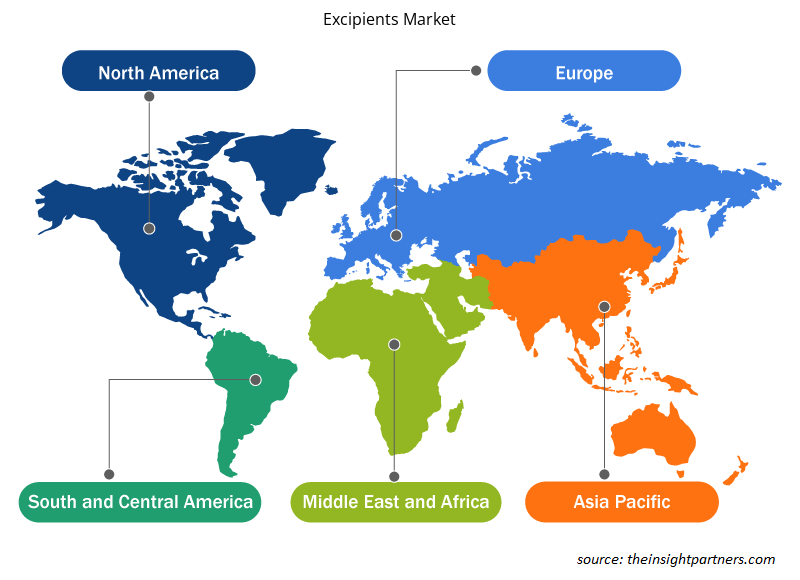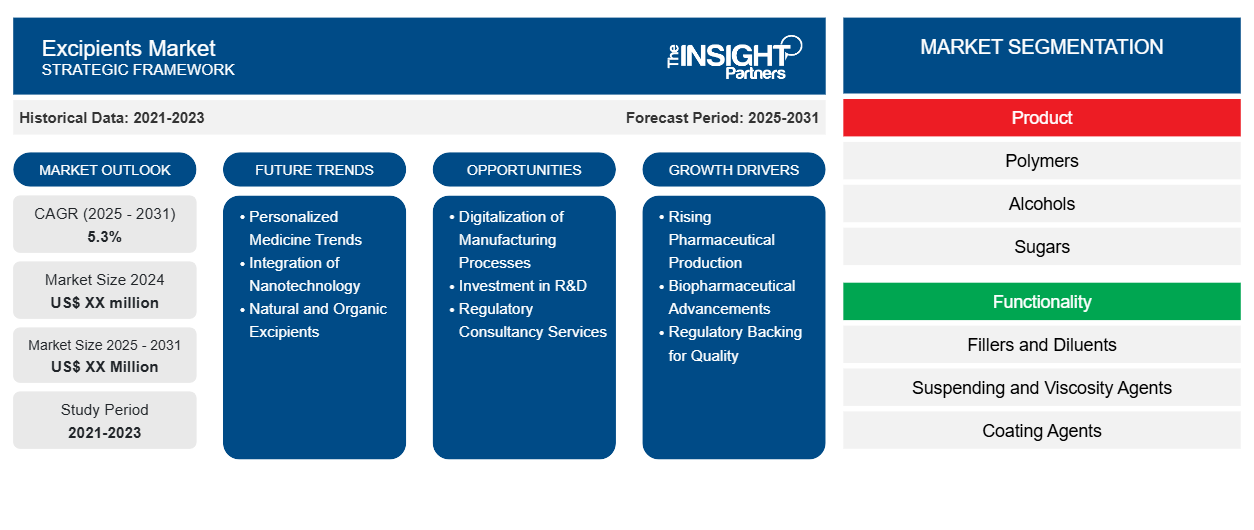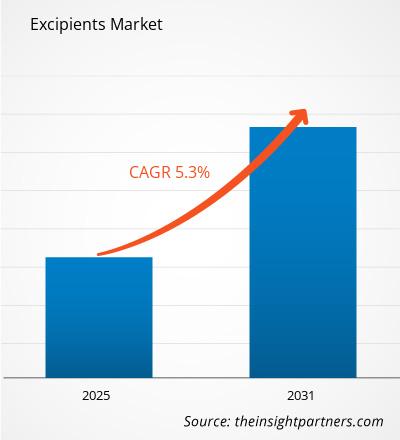賦形剤市場は、2024年から2031年にかけて5.3%のCAGRで成長すると予想されており、市場規模は2024年のXX百万米ドルから2031年にはXX百万米ドルに拡大する見込みです。
レポートは、製品(ポリマー、アルコール、糖、ミネラル、ゼラチン)別にセグメント化されています。レポートは、機能性(充填剤および希釈剤、懸濁剤および粘性剤、コーティング剤、結合剤、香味剤および甘味料、その他)に基づいてさらにセグメント化されています。さらに、処方(経口処方、局所処方、非経口処方、その他の処方)に基づいてセグメント化されています。グローバル分析は、地域レベルおよび主要国でさらに細分化されています。レポートは、上記の分析とセグメントの値をUSDで提供しています。
報告書の目的
The Insight Partners の「賦形剤市場」レポートは、現在の状況と将来の成長、主な推進要因、課題、機会を説明することを目的としています。これにより、次のようなさまざまなビジネス関係者に洞察が提供されます。
- テクノロジープロバイダー/メーカー: 進化する市場の動向を理解し、潜在的な成長機会を把握することで、情報に基づいた戦略的意思決定が可能になります。
- 投資家: 市場の成長率、市場の財務予測、バリュー チェーン全体に存在する機会に関する包括的な傾向分析を実施します。
- 規制機関: 市場の濫用を最小限に抑え、投資家の信用と信頼を維持し、市場の完全性と安定性を維持することを目的として、市場における政策と警察活動を規制します。
添加剤市場のセグメンテーション
製品
- ポリマー
- アルコール
- 糖類
- 鉱物
- ゼラチン
機能性
- 充填剤と希釈剤
- 懸濁剤および粘性剤
- コーティング剤
- バインダー
- 香料および甘味料
- その他
処方
- 経口製剤
- 局所用製剤
- 非経口製剤
- その他の処方
地理
- 北米
- ヨーロッパ
- アジア太平洋
- 南米と中央アメリカ
- 中東およびアフリカ
要件に合わせてレポートをカスタマイズする
このレポートの一部、国レベルの分析、Excelデータパックなど、あらゆるレポートを無料でカスタマイズできます。また、スタートアップや大学向けのお得なオファーや割引もご利用いただけます。
- このレポートの主要な市場動向を入手してください。この無料サンプルには、市場動向から見積もりや予測に至るまでのデータ分析が含まれます。
添加剤市場の成長要因
- 医薬品生産の増加: 添加剤市場は、人口の高齢化と慢性疾患による医薬品生産の増加によって主に牽引されています。薬剤処方の複雑さが、薬剤の有効性と安定性を高めるカスタマイズされた添加剤が不可欠である主な理由です。
- バイオ医薬品の進歩: モノクローナル抗体やワクチンなどのバイオ医薬品に関しては、新しく改良された賦形剤が必要です。これらはバイオアベイラビリティと溶解性を改善し、効果的なバイオ医薬品製剤の開発を可能にし、それによって賦形剤市場を大幅に拡大します。
- 品質に対する規制の裏付け: 医薬品の品質と安全性に関する規制が強化され、高品質の添加剤の使用が義務付けられています。基準が厳しくなると、メーカーはより優れた添加剤材料に投資するようになり、企業のコンプライアンスと製品の完全性が利益を上回るため、市場が拡大します。
添加剤市場の将来動向
- パーソナライズ医療のトレンド: パーソナライズ医療への移行により、カスタマイズされた医薬品製剤用に配合された特定の賦形剤が必要になります。このトレンドにより、メーカーは治療効果を改善できる特注の配合を利用できるため、新しい賦形剤の開発が促進されます。
- ナノテクノロジーの統合: 賦形剤へのナノテクノロジーの組み込みは重要なトレンドになりつつあります。ナノ粒子は薬剤の送達と安定性の両方を強化します。したがって、薬剤放出に基づく複合製剤の革新は賦形剤市場での優位性をもたらし、治療効果を向上させます。
- 天然および有機の賦形剤: 天然および有機製品に対する消費者の関心が高まるにつれて、顧客が天然賦形剤を探す方法も確実に変化しています。処方開発では、グリーン代替品が十分な勢いを増し、賦形剤市場を持続可能性へと方向転換させています。
賦形剤市場の機会
- 製造プロセスのデジタル化: デジタル化により、賦形剤製造プロセスの効率化と品質管理の向上が実現します。人工知能や自動化などの高度なテクノロジーにより、生産能力が向上し、コストが削減され、賦形剤市場におけるイノベーションが加速します。
- 研究開発への投資: 研究開発への投資を増やすことで、新たな賦形剤の可能性が開けるはずです。革新的な配合と持続可能な材料に重点を置くことで、メーカーは自社の製品を差別化し、進化する市場の需要を満たす機会を得ることができます。
- 規制コンサルティング サービス: 規制要件が増加する中、コンプライアンスを順守するためのコンサルティング サービスは、新たな収益源となる可能性があります。賦形剤の選択と規制要件に関する専門知識は、製薬会社が製品の安全性と有効性を確保し、賦形剤市場を改善するのに役立ちます。
賦形剤市場の地域別洞察
予測期間を通じて賦形剤市場に影響を与える地域的な傾向と要因は、Insight Partners のアナリストによって徹底的に説明されています。このセクションでは、北米、ヨーロッパ、アジア太平洋、中東、アフリカ、南米、中米にわたる賦形剤市場のセグメントと地理についても説明します。

- 賦形剤市場の地域別データを入手
賦形剤市場レポートの範囲
| レポート属性 | 詳細 |
|---|---|
| 2024年の市場規模 | XX百万米ドル |
| 2031年までの市場規模 | XX百万米ドル |
| 世界のCAGR(2024年 - 2031年) | 5.3% |
| 履歴データ | 2021-2023 |
| 予測期間 | 2025-2031 |
| 対象セグメント | 製品別
|
| 対象地域と国 | 北米
|
| 市場リーダーと主要企業プロフィール |
|
添加剤市場のプレーヤー密度:ビジネスダイナミクスへの影響を理解する
賦形剤市場は、消費者の嗜好の変化、技術の進歩、製品の利点に対する認識の高まりなどの要因により、エンドユーザーの需要が高まり、急速に成長しています。需要が高まるにつれて、企業は提供品を拡大し、消費者のニーズを満たすために革新し、新たなトレンドを活用し、市場の成長をさらに促進しています。
市場プレーヤー密度とは、特定の市場または業界内で活動している企業または会社の分布を指します。これは、特定の市場スペースに、その規模または総市場価値と比較して、どれだけの競合相手 (市場プレーヤー) が存在するかを示します。
賦形剤市場で事業を展開している主要企業は次のとおりです。
- アッシュランド・グローバル・ホールディングス
- BASF SE
- デュポン
- ロケット・フェレス
- エボニック インダストリーズ AG
免責事項:上記の企業は、特定の順序でランク付けされていません。

- 賦形剤市場のトップキープレーヤーの概要を入手
主なセールスポイント
- 包括的なカバレッジ: レポートでは、賦形剤市場の製品、サービス、タイプ、エンドユーザーの分析を包括的にカバーし、全体的な展望を提供します。
- 専門家による分析: レポートは、業界の専門家とアナリストの深い理解に基づいてまとめられています。
- 最新情報: このレポートは、最新の情報とデータの傾向を網羅しているため、ビジネスの関連性を保証します。
- カスタマイズ オプション: このレポートは、特定のクライアント要件に対応し、ビジネス戦略に適切に適合するようにカスタマイズできます。
したがって、賦形剤市場に関する調査レポートは、業界のシナリオと成長の見通しを解読し理解する道の先導役となることができます。いくつかの正当な懸念があるかもしれませんが、このレポートの全体的な利点は欠点を上回る傾向があります。
- 過去2年間の分析、基準年、CAGRによる予測(7年間)
- PEST分析とSWOT分析
- 市場規模価値/数量 - 世界、地域、国
- 業界と競争環境
- Excel データセット



Report Coverage
Revenue forecast, Company Analysis, Industry landscape, Growth factors, and Trends

Segment Covered
This text is related
to segments covered.

Regional Scope
North America, Europe, Asia Pacific, Middle East & Africa, South & Central America

Country Scope
This text is related
to country scope.
よくある質問
BASF SE and DuPont are some of the major players operating in the market.
Asia Pacific region accounted for the highest CAGR in the excipients market.
The report provides an extensive qualitative and quantitative analysis of the current trends and future estimations of the global excipients market from 2021 to 2031, and it also determines the prevailing opportunities.
The major factors driving the excipients market are:
1. Biopharmaceutical Advancements.
2. Regulatory Backing for Quality.
North America region dominated the excipients market in 2023.
The Excipients Market is estimated to witness a CAGR of 5.3% from 2023 to 2031
Trends and growth analysis reports related to Life Sciences : READ MORE..
1. Ashland Global Holdings
2. BASF SE
3. DuPont
4. Roquette Feres
5. Evonik Industries AG
6. Associated British Foods
7. Archer Daniels Midland Company
8. Lubrizol Corporation
9. Croda International
10. Innophous Holdings
11. Kerry Group
12. WACKER Chemie AG
13. Colorcon
14. DFE Pharma JRS Pharma
15. Air Liquide
The Insight Partners performs research in 4 major stages: Data Collection & Secondary Research, Primary Research, Data Analysis and Data Triangulation & Final Review.
- Data Collection and Secondary Research:
As a market research and consulting firm operating from a decade, we have published and advised several client across the globe. First step for any study will start with an assessment of currently available data and insights from existing reports. Further, historical and current market information is collected from Investor Presentations, Annual Reports, SEC Filings, etc., and other information related to company’s performance and market positioning are gathered from Paid Databases (Factiva, Hoovers, and Reuters) and various other publications available in public domain.
Several associations trade associates, technical forums, institutes, societies and organization are accessed to gain technical as well as market related insights through their publications such as research papers, blogs and press releases related to the studies are referred to get cues about the market. Further, white papers, journals, magazines, and other news articles published in last 3 years are scrutinized and analyzed to understand the current market trends.
- Primary Research:
The primarily interview analysis comprise of data obtained from industry participants interview and answers to survey questions gathered by in-house primary team.
For primary research, interviews are conducted with industry experts/CEOs/Marketing Managers/VPs/Subject Matter Experts from both demand and supply side to get a 360-degree view of the market. The primary team conducts several interviews based on the complexity of the markets to understand the various market trends and dynamics which makes research more credible and precise.
A typical research interview fulfils the following functions:
- Provides first-hand information on the market size, market trends, growth trends, competitive landscape, and outlook
- Validates and strengthens in-house secondary research findings
- Develops the analysis team’s expertise and market understanding
Primary research involves email interactions and telephone interviews for each market, category, segment, and sub-segment across geographies. The participants who typically take part in such a process include, but are not limited to:
- Industry participants: VPs, business development managers, market intelligence managers and national sales managers
- Outside experts: Valuation experts, research analysts and key opinion leaders specializing in the electronics and semiconductor industry.
Below is the breakup of our primary respondents by company, designation, and region:

Once we receive the confirmation from primary research sources or primary respondents, we finalize the base year market estimation and forecast the data as per the macroeconomic and microeconomic factors assessed during data collection.
- Data Analysis:
Once data is validated through both secondary as well as primary respondents, we finalize the market estimations by hypothesis formulation and factor analysis at regional and country level.
- Macro-Economic Factor Analysis:
We analyse macroeconomic indicators such the gross domestic product (GDP), increase in the demand for goods and services across industries, technological advancement, regional economic growth, governmental policies, the influence of COVID-19, PEST analysis, and other aspects. This analysis aids in setting benchmarks for various nations/regions and approximating market splits. Additionally, the general trend of the aforementioned components aid in determining the market's development possibilities.
- Country Level Data:
Various factors that are especially aligned to the country are taken into account to determine the market size for a certain area and country, including the presence of vendors, such as headquarters and offices, the country's GDP, demand patterns, and industry growth. To comprehend the market dynamics for the nation, a number of growth variables, inhibitors, application areas, and current market trends are researched. The aforementioned elements aid in determining the country's overall market's growth potential.
- Company Profile:
The “Table of Contents” is formulated by listing and analyzing more than 25 - 30 companies operating in the market ecosystem across geographies. However, we profile only 10 companies as a standard practice in our syndicate reports. These 10 companies comprise leading, emerging, and regional players. Nonetheless, our analysis is not restricted to the 10 listed companies, we also analyze other companies present in the market to develop a holistic view and understand the prevailing trends. The “Company Profiles” section in the report covers key facts, business description, products & services, financial information, SWOT analysis, and key developments. The financial information presented is extracted from the annual reports and official documents of the publicly listed companies. Upon collecting the information for the sections of respective companies, we verify them via various primary sources and then compile the data in respective company profiles. The company level information helps us in deriving the base number as well as in forecasting the market size.
- Developing Base Number:
Aggregation of sales statistics (2020-2022) and macro-economic factor, and other secondary and primary research insights are utilized to arrive at base number and related market shares for 2022. The data gaps are identified in this step and relevant market data is analyzed, collected from paid primary interviews or databases. On finalizing the base year market size, forecasts are developed on the basis of macro-economic, industry and market growth factors and company level analysis.
- Data Triangulation and Final Review:
The market findings and base year market size calculations are validated from supply as well as demand side. Demand side validations are based on macro-economic factor analysis and benchmarks for respective regions and countries. In case of supply side validations, revenues of major companies are estimated (in case not available) based on industry benchmark, approximate number of employees, product portfolio, and primary interviews revenues are gathered. Further revenue from target product/service segment is assessed to avoid overshooting of market statistics. In case of heavy deviations between supply and demand side values, all thes steps are repeated to achieve synchronization.
We follow an iterative model, wherein we share our research findings with Subject Matter Experts (SME’s) and Key Opinion Leaders (KOLs) until consensus view of the market is not formulated – this model negates any drastic deviation in the opinions of experts. Only validated and universally acceptable research findings are quoted in our reports.
We have important check points that we use to validate our research findings – which we call – data triangulation, where we validate the information, we generate from secondary sources with primary interviews and then we re-validate with our internal data bases and Subject matter experts. This comprehensive model enables us to deliver high quality, reliable data in shortest possible time.


 このレポートの無料サンプルを入手する
このレポートの無料サンプルを入手する